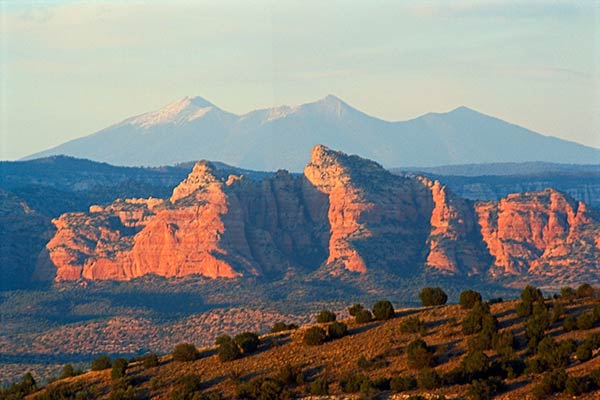
Sacred Kachina Peak and Sedona Red Rocks, Arizona (Enlarge)
Situated in northern Arizona at an elevation of 4500 feet, the famous Red Rocks of Sedona are one of the most beautiful natural sites in the United States. Part of the eroding Mogollon Rim of the vast Colorado plateau, Sedona's canyon walls show nine layers of stone from different geological periods spanning hundreds of millions of years. There are six layers of sandstone, two thin layers of limestone and atop all of these, one igneous layer of basalt stone. The different sandstone and limestone layers were formed by wind blown sand dunes or mud deposited by inland seas. The red colors of some of the sandstone layers are the result of iron oxide staining the rocks over great periods of time. The uppermost igneous layer was deposited by volcanic eruptions 14.5 million years ago and once covered the entire Verde Valley several meters deep in lava. The Verde Valley, meaning Green Valley, is so named because of the natural copper, appearing green when extracted from the ground, which had long been mined in the nearby hills and not because of the colors of local vegetation. The waters of Oak Creek come from the many natural springs along the course of the creek and not, as is commonly assumed, from melting snow of the nearby sacred mountain of Kachina Peak.
Evidence of human presence in the Sedona region begins around 4000 BC when hunter-gatherers roamed through the Verde Valley. As early as 300 BC the dry desert soils were being farmed by the Hohokam people, who developed systems of irrigation canals by 700 AD but then mysteriously abandoned the area, perhaps because of a regional volcanic eruption in 1066 AD. Next to arrive were the agrarian Sinagua Indians, whose Spanish name means 'without water,' this being an indication of their ability to farm in the dry environment. Settling in the area from about 1000 to 1400 AD, they built pueblos and cliff dwellings, perhaps influenced by the architecturally more sophisticated Anasazi Indians, and made baskets, pottery and jewelry. They also established trading relationships with tribes from the Pacific coastal regions and northern Mexico, and exported the high grade copper which they mined west of Sedona. Traces of the Sinagua may be found in the remains of their ruined pueblos scattered around the Sedona area. Sites such as Palatki, Honanki, and Wupatki had dozens of rooms in double story buildings and were decorated with intriguing pictographs and petroglyphs depicting clan affiliations, mythological beings and astronomical observations. Archaeologists theorize that the Sinagua may have conducted religious celebrations during particular periods determined by their celestial observations. Early in the 15th century, the Sinagua disappeared from the area for reasons which remain a mystery and about this time the Yavapai and Apache Indians began to settle along the sides of Oak Creek canyon.
Europeans first arrived in the region in 1583, when a group of Spanish explorers came in search of gold and silver. Following the end of the Civil War and the creation of the Territory of Arizona in 1863, homesteaders began to settle in the Verde Valley and along Oak Creek from the 1870's. Growth was slow at first because of the remoteness of the region and in 1902 the small town was named Sedona after the name of the local postmaster's wife, Sedona Schnebly. The first spurt of development came during the 1940's and 50's when Hollywood began filming western movies amidst the red rocks, such as the classics Billy the Kid, Apache and Broken Arrow. In the 1960s and '70s the beauty of the red rocks began attracting retirees, artists and an increasing number of tourists. Currently more than four million visitors pass through Sedona each year.
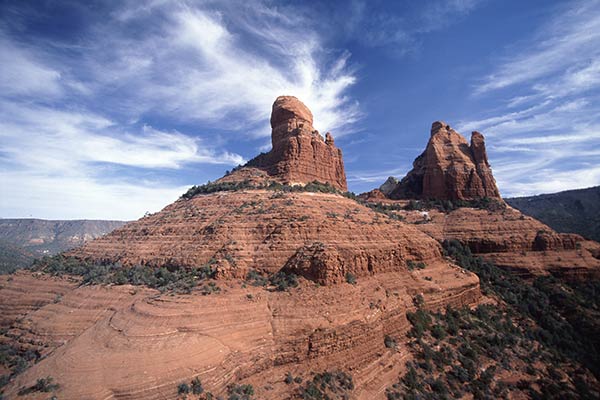
Sedona Red Rocks, Arizona (Enlarge)
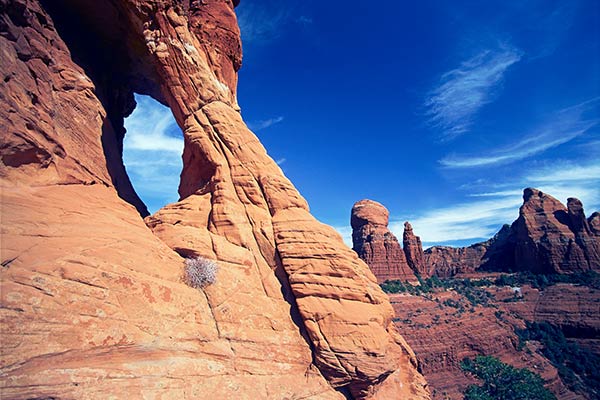
Sedona Red Rocks, Arizona (Enlarge)

Sedona Red Rocks, Arizona (Enlarge)
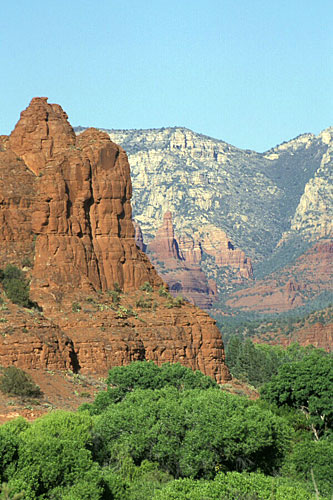
Sedona Red Rocks, Arizona
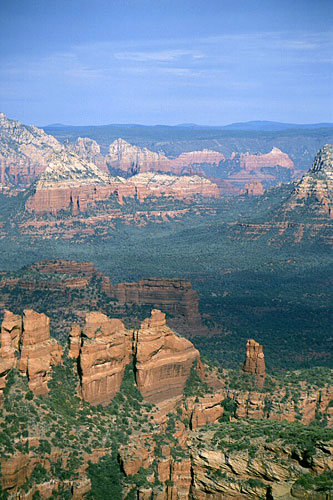
Sedona Red Rocks, Arizona
 Martin Gray is a cultural anthropologist, writer and photographer specializing in the study of pilgrimage traditions and sacred sites around the world. During a 40 year period he has visited more than 2000 pilgrimage places in 165 countries. The World Pilgrimage Guide at sacredsites.com is the most comprehensive source of information on this subject.
Martin Gray is a cultural anthropologist, writer and photographer specializing in the study of pilgrimage traditions and sacred sites around the world. During a 40 year period he has visited more than 2000 pilgrimage places in 165 countries. The World Pilgrimage Guide at sacredsites.com is the most comprehensive source of information on this subject.